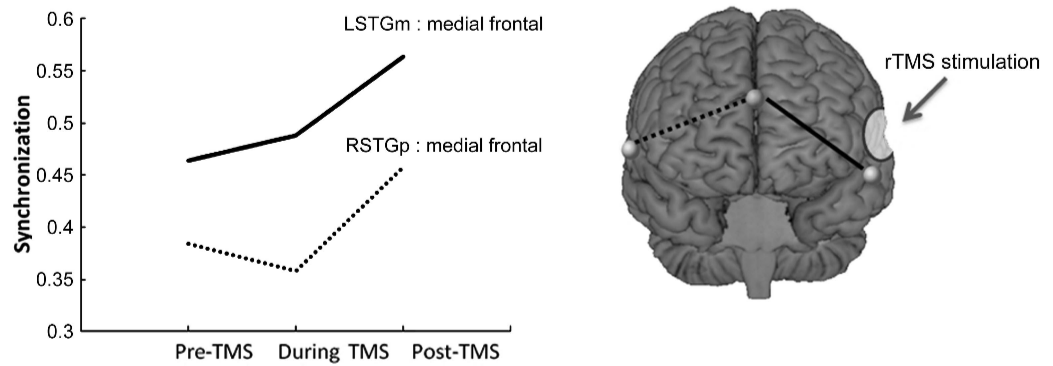How the brain quickly rebounds from injuries
February 18, 2013

Increased synchronization (left) of compensatory regions of the brain after rTMS (right) (credit: Robert A. Mason et al./Cerebral Cortex)
Scientists at Carnegie Mellon University‘s Center for Cognitive Brain Imaging (CCBI) have used a new combination of neural imaging methods to discover exactly how the human brain adapts to injury.
When one brain area loses functionality, a “back-up” team of secondary brain areas immediately activates, replacing not only the unavailable area but also its confederates (connected areas), the research shows.
For the study, Robert Mason, senior research psychologist at CMU, and Chantel Prat, assistant professor of psychology at the University of Washington, used functional magnetic resonance imaging (fMRI) to study precisely how the brains of 16 healthy adults adapted to the temporary incapacitation of the Wernicke area, the brain’s key region involved in language comprehension.
Applying TMS to momentarily disable language comprehension
They applied repetitive transcranial magnetic stimulation (rTMS) to temporarily disable the Wernicke area in the participants’ brains, during an fMRI scan.
The participants, while in the fMRI scanner, were performing a sentence comprehension task before, during and after the rTMS was applied. Normally, the Wernicke area is a major player in sentence comprehension.
The research found that as the brain function in the Wernicke area decreased following the application of rTMS, a “back-up” team of secondary brain areas immediately became activated and coordinated, allowing the individual’s thought process to continue with no decrease in comprehension performance.
“The human brain has a remarkable ability to adapt to various types of trauma, such as traumatic brain injury and stroke, making it possible for people to continue functioning after key brain areas have been damaged,” said Marcel Just, the D. O. Hebb Professor of Psychology at CMU and CCBI director.
“It is now clear how the brain can naturally rebound from injuries. It gives us indications of how individuals can train their brains to be prepared for easier recovery. The secret is to develop alternative thinking styles, the way a switch-hitter develops alternative batting styles. Then, if a muscle in one arm is injured, they can use the batting style that relies more on the uninjured arm.”